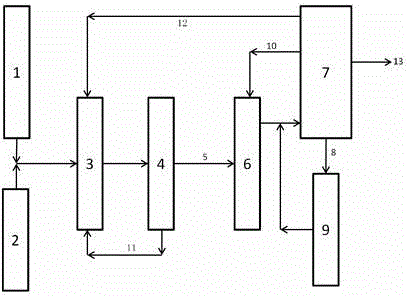Method for producing 2,6-dimethylnaphthalene by using amylene in fischer-tropsch reaction product
A kind of technology of dimethylnaphthalene and reaction product, applied in the field of producing 2,6-dimethylnaphthalene
- Summary
- Abstract
- Description
- Claims
- Application Information
AI Technical Summary
Problems solved by technology
Method used
Image
Examples
example 1
[0022] see attached figure 1 , a method for producing 2,6-dimethylnaphthalene from pentene in the Fischer-Tropsch reaction product, mainly comprising a Fischer-Tropsch pentene separation unit, an alkylation unit, a separation device, a cyclodehydrogenation unit, and an isomerization unit, 2,6-dimethylnaphthalene separation unit.
[0023] figure 1 Shown is a method of utilizing pentene in the Fischer-Tropsch reaction product to produce 2,6-dimethylnaphthalene, the Fischer-Tropsch product enters the Fischer-Tropsch pentene separation unit 1, and the pentene in the product is separated from other products, The olefins separated from the pentene separation unit are mixed with toluene 2 and then enter the alkylation unit 3. In the alkylation unit, the pentene and toluene undergo an alkylation reaction to form C 12 The mixture of polyalkylbenzenes of the components makes the pentene of the Fischer-Tropsch product react with toluene, the molar ratio of toluene to olefins is equal t...
example 2
[0027] See attached figure 1 , a method for producing 2,6-dimethylnaphthalene from pentene in the Fischer-Tropsch reaction product, mainly comprising a Fischer-Tropsch pentene separation unit, an alkylation unit, a separation device, a cyclodehydrogenation unit, and an isomerization unit, 2,6-dimethylnaphthalene separation unit.
[0028] figure 1 Shown is a method of utilizing pentene in the Fischer-Tropsch reaction product to produce 2,6-dimethylnaphthalene, the Fischer-Tropsch product enters the Fischer-Tropsch pentene separation unit 1, and the pentene in the product is separated from other products, The olefins separated from the pentene separation unit are mixed with toluene 2 and then enter the alkylation unit 3. In the alkylation unit, the pentene and toluene undergo an alkylation reaction to form C 12 The mixture of polyalkylbenzenes of the components reacts the pentene and toluene of the Fischer-Tropsch product, the molar ratio of toluene to olefin is equal to 5-9, ...
example 3
[0033] See attached figure 1 , a method for producing 2,6-dimethylnaphthalene from pentene in the Fischer-Tropsch reaction product, mainly comprising a Fischer-Tropsch pentene separation unit, an alkylation unit, a separation device, a cyclodehydrogenation unit, and an isomerization unit, 2,6-dimethylnaphthalene separation unit.
[0034] figure 1 Shown is a method of utilizing pentene in the Fischer-Tropsch reaction product to produce 2,6-dimethylnaphthalene, the Fischer-Tropsch product enters the Fischer-Tropsch pentene separation unit 1, and the pentene in the product is separated from other products, The olefins separated from the pentene separation unit are mixed with toluene 2 and then enter the alkylation unit 3. In the alkylation unit, the pentene and toluene undergo an alkylation reaction to form C 12 The mixture of polyalkylbenzenes of the components reacts the pentene and toluene of the Fischer-Tropsch product, the molar ratio of toluene and olefin is equal to 3 to...
PUM
 Login to View More
Login to View More Abstract
Description
Claims
Application Information
 Login to View More
Login to View More - R&D
- Intellectual Property
- Life Sciences
- Materials
- Tech Scout
- Unparalleled Data Quality
- Higher Quality Content
- 60% Fewer Hallucinations
Browse by: Latest US Patents, China's latest patents, Technical Efficacy Thesaurus, Application Domain, Technology Topic, Popular Technical Reports.
© 2025 PatSnap. All rights reserved.Legal|Privacy policy|Modern Slavery Act Transparency Statement|Sitemap|About US| Contact US: help@patsnap.com

